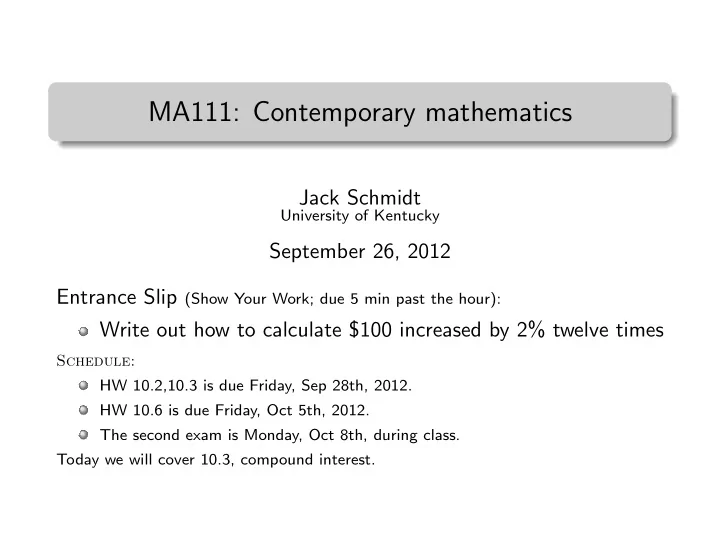

. MA111: Contemporary mathematics . Jack Schmidt University of Kentucky September 26, 2012 Entrance Slip (Show Your Work; due 5 min past the hour): Write out how to calculate $100 increased by 2% twelve times Schedule: HW 10.2,10.3 is due Friday, Sep 28th, 2012. HW 10.6 is due Friday, Oct 5th, 2012. The second exam is Monday, Oct 8th, during class. Today we will cover 10.3, compound interest.
Context: interest on interest Suppose you need money a year later, not now A bank will pay you simple interest, 2% per month If you put in $100, each month you get $2 in interest By the end, you’ve got $100+$24 = $124 Can you do better? Spend the $2 at the bank across the street They’ll give you $0.04 per month for 11 months By the end, you’ve got $124.44 Why would the first bank want to lose your business?
Activity: compounding interest If banks only offered 2% per month simple interest paid monthly What is the most you could make in 12 months? (just using interest) Would you be better off using a bank that offered 25% per year simple interest, if it paid out at the end of a year? How would you compare per month and per year interest rates in general?
Activity: Proposed answer Each month you re-invest, and the total grows by 2% Entrance slip answer: $100(1 . 02) 12 = $126 . 82 $24 interest on the original, Another $2.82 total from the interest on interest More than 10% of the interest was from interest on interest How do we compare? Just run the money through both investments. Monthly we got 26.82% interest in 12 months; better than 25% This is why we learn to calculate: don’t waste a year waiting for the bank statements to tell you which is better; calculate now and then enjoy the benefits
Fast: 10.3: Compound interest formulas The following formula is important enough to memorize: P = Present value F = Future value p = periodic compound interest rate T = number of periods F = P (1 + p ) T Same as repeatedly doing simple interest for 1 period
Fast: 10.3: Monthly example Our activity example: P = $100 F = ? p = 0 . 02 (per month) T = 12 (months) F = P (1 + p ) T = $100(1 + 0 . 02) 12 = $100(1 . 02) 12 F = $126 . 82
Fast: 10.3: Yearly example Compare to the other bank in the activity: P = $100 F = ? p = 0 . 25 (per year) T = 1 (year) F = P (1 + p ) T = $100(1 + 0 . 25) 1 = $100(1 . 25) F = $125 . 00, not as big
Fast: 10.3: More compound interest formulas These formulas are not worth memorizing, in my opinion P = Present value F = Future value APR = r = annual, nominal, compound interest Rate n = Number of periods per year t = number of years APY = r eff = annual effective Yield (what you actually get) ) ( nt ) 1 + r ( F = P n 1 + r ) ( n ) ( APY = − 1 n If n = ∞ , then we get: F = Pe ( rt )
Fast: APR versus APY Example A bank won’t usually call it 2% per month Often they call it 24% APR, (2% per month times 12 months per year) But we saw that our $100 became $126.82, more than 24% What percent per year was it? P = $100 F = $126 . 82 p = ? (per year) T = 1 (year) $126 . 82 = $100(1 + p ) $126 . 82 = $100 + $100 p $26 . 82 = $100 p p = $26 . 82 / $100 = 0 . 2682 = 26 . 82% APY
Assignment and exit slip Reread and understand 10.3 Read 10.6 (you may want to very lightly skim 10.4 and 10.5) Exit slip: Which is the better deal if you need the money 24 months from now? (a) 2% per month for 24 months (b) 26.82% per year for 2 years (so you get the interest after 12 months, and re-invest) What does this tell you about using the APY?
Recommend
More recommend